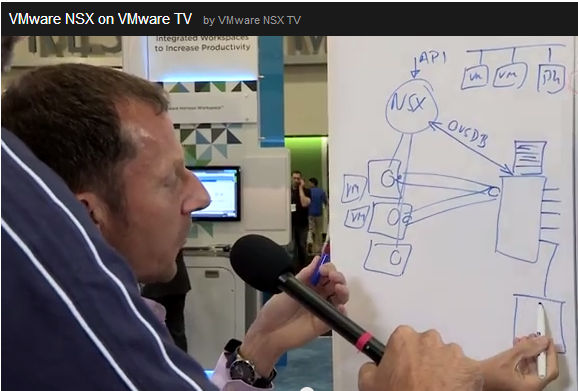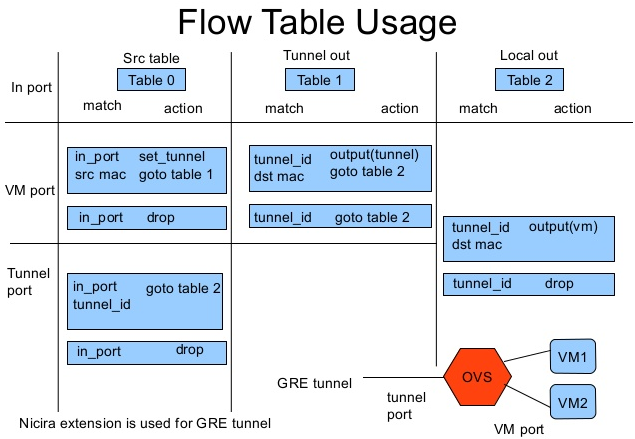Tornado is a Python web framework and asynchronous networking library
http://www.tornadoweb.org/en/stable/
a powerful interactive packet manipulation program
http://www.secdev.org/projects/scapy/
Thursday, December 26, 2013
Tuesday, December 3, 2013
[NSX] Network Visualization Gets Physical
In VMware NSX, how to let network visualization gets physical?
The answer is "Layer 2 Gateway Services". The physical switches have to implement the OVSDB and related APIs that communicate with NSX Controller so that they can provide the mapping of the segment in virtual network and VLAN in physical network. For more information in details, you can check out the following URLs.
http://networkheresy.com/2013/08/15/network-virtualization-gets-physical/

https://www.youtube.com/watch?v=QDOlggwyrVA&feature=c4-overview-vl&list=PLdYldEmmLm2lz5Bd0bzGCDKSULL52ytJT
Ivan's NSX Architecture Introduction, it is very good.
http://demo.ipspace.net/get/NSXArch
The answer is "Layer 2 Gateway Services". The physical switches have to implement the OVSDB and related APIs that communicate with NSX Controller so that they can provide the mapping of the segment in virtual network and VLAN in physical network. For more information in details, you can check out the following URLs.
http://networkheresy.com/2013/08/15/network-virtualization-gets-physical/

https://www.youtube.com/watch?v=QDOlggwyrVA&feature=c4-overview-vl&list=PLdYldEmmLm2lz5Bd0bzGCDKSULL52ytJT
Ivan's NSX Architecture Introduction, it is very good.
http://demo.ipspace.net/get/NSXArch
Tuesday, November 19, 2013
[OpenVNet] The introduction of OpenVNet
Why I pay attention to OpenVNet is because it uses Trema-Edge as OpenFlow 1.3 Controller to communicate with Open vSwitch 1.10. It gives us a great example to use Trema-Edge in Virtual Network Environment and learn more about some use cases. Please check out the following lists:
What is OpenVNet?
http://www.slideshare.net/akirayokokawa/openvnet
Offical Web Site:
http://openvnet.com/
Github Source:
https://github.com/axsh/openvnet
What is OpenVNet?
http://www.slideshare.net/akirayokokawa/openvnet
Offical Web Site:
http://openvnet.com/
Github Source:
https://github.com/axsh/openvnet
[Quagga] How to compile and install Quagga on Ubuntu 12.04
The following steps are the compilation and installation for Quagga on Ubuntu 12.04. Hopefully it is helpful for you.
- Install all dependency(package)
- sudo apt-get build-dep quagga
- Give the path for all configurations files and libraries used by quagga for starting. I use this one /opt/quagga .... and this is done by this comand:
- ./configure --enable-vtysh --prefix=/opt/quagga --localstatedir=/opt/quagga sysconfdir=/opt/quagga
- Create new folder:
- sudo mkdir /opt/quagga
- Add new user :
- sudo adduser quagga
- Give the priviledge for the user quagga over the folder: /opt/quagga and for the folders and subfolders you give the privilegde for all rights : reading, changing and executing
- sudo chown quagga:quagga /opt/quagga
- sudo chmod 777 /opt/quagga
- Then you will be able to comiple Quagga:
- make
- sudo make install
Quagga configuration -------------------- quagga version : 0.99.22 host operating system : linux-gnu source code location : . compiler : gcc compiler flags : -Os -fno-omit-frame-pointer -g -std=gnu99 -Wall -Wsign-compare -Wpointer-arith -Wbad-function-cast -Wwrite-strings -Wmissing-prototypes -Wmissing-declarations -Wchar-subscripts -Wcast-qual make : make includes : linker flags : -lcrypt -lrt -lcap -lm state file directory : /opt/quagga config file directory : /opt/quagga example directory : /opt/quagga user to run as : quagga group to run as : quagga group for vty sockets : config file mask : 0600 log file mask : 0600
- Zebra
- Copy sample to conf file:
- cd /opt/quagga
- cp zebra.conf.sample zebra.conf
- Start zebra daemon, you use this command
- sudo /opt/quagga/sbin/zebra &
- Check the daemon zebra:
- netstat -a | grep zebra
- Get into the zebra, you use
- telnet localhost zebra
- BGP
- Copy sample to conf file:
- cd /opt/quagga
- cp bgpd.conf.sample bgpd.conf
- Start bgpd:
- sudo /opt/quagga/sbin/bgpd &
- Check the daemon zebra:
- netstat -a | grep bgpd
- Get into the bgpd, you use
- telnet localhost bgpd
- vtysh
- cd /opt/quagga
- vi /opt/quagga/vtysh.conf
- sudo /opt/quagga/bin/vtysh
! Sample configuration file for vtysh. ! !service integrated-vtysh-config hostname quagga-router username root nopassword !
- sudo kill `cat /opt/quagga/bgpd.pid`
Port Number:
- zebra: 2601
- ripd: 2602
- ripng: 2603
- ospfd: 2604
- bgpd: 2605
- ospf6d: 2606
Reference:
http://openmaniak.com/quagga_tutorial.php
http://openmaniak.com/quagga_tutorial.php
Tuesday, November 12, 2013
[EVB] What is EVB?
The introduction of EVB
http://networkerhere.blogspot.tw/2012/11/impact-of-server-virtualization-on_13.html
http://blog.ipspace.net/2011/05/edge-virtual-bridging-evb-8021qbg-eases.html
Due to overlay network, EVB is becoming to die ...!? The most main reason is that VLAN is not able to scale:
http://blog.ipspace.net/2012/02/edge-virtual-bridging-8021qbg.html
There are also some similar approaches, such as, VN-Tags that can do the same thing as EVB.
http://www.definethecloud.net/access-layer-network-virtualization-vn-tag-and-vepa/
http://networkerhere.blogspot.tw/2012/11/impact-of-server-virtualization-on_13.html
http://blog.ipspace.net/2011/05/edge-virtual-bridging-evb-8021qbg-eases.html
Due to overlay network, EVB is becoming to die ...!? The most main reason is that VLAN is not able to scale:
http://blog.ipspace.net/2012/02/edge-virtual-bridging-8021qbg.html
There are also some similar approaches, such as, VN-Tags that can do the same thing as EVB.
http://www.definethecloud.net/access-layer-network-virtualization-vn-tag-and-vepa/
Friday, November 8, 2013
[Puppet] The studying track of Puppet
After taking some time to study Puppet a while, I become to believe more and more that it is a great auto configuration tool. The following URLs are my studying track of Puppet.
For the beginner, it is recommended to walk through for learning the basic concept
Learning Puppet
http://docs.puppetlabs.com/learning/index.html
Once you finish the above document, you probably want to do your own type and provider. Here you go:
Customer Type
http://docs.puppetlabs.com/guides/custom_types.html
Provider Development
http://docs.puppetlabs.com/guides/provider_development.html
Juniper provides its open source project for using Puppet to manage and configure the switches that support Puppet Agent. It is a very good example for you to understand how to define customer type and to implement provider.
To define customer type:
https://github.com/NetdevOps/puppet-netdev-stdlib
To implement provider:
https://github.com/Juniper/puppet-netdev-stdlib-junos
For the beginner, it is recommended to walk through for learning the basic concept
Learning Puppet
http://docs.puppetlabs.com/learning/index.html
Once you finish the above document, you probably want to do your own type and provider. Here you go:
Customer Type
http://docs.puppetlabs.com/guides/custom_types.html
Provider Development
http://docs.puppetlabs.com/guides/provider_development.html
Juniper provides its open source project for using Puppet to manage and configure the switches that support Puppet Agent. It is a very good example for you to understand how to define customer type and to implement provider.
To define customer type:
https://github.com/NetdevOps/puppet-netdev-stdlib
To implement provider:
https://github.com/Juniper/puppet-netdev-stdlib-junos
Monday, November 4, 2013
[OpenFlow 1.X] The Flow Table Usage
When OpenFlow 1.0 guys try to reach the version 1.1 or more, the first question coming up with would most likely be "how to use multi-flow tables ?" Well, we could see an example in RYU OpenFlow Controller as follow: http://www.slideshare.net/yamahata/ryu-sdnframeworkupload
In page 33, there are 3 flow tables which contains match conditons and actions. It can give an initial idea for that question.

P.S: Pica8 works with Broadcom to double flow table size in its OF1.3 Switch
http://searchsdn.techtarget.com/news/2240214709/Pica8-doubles-flow-rule-capacity-in-its-new-OpenFlow-13-switch
In page 33, there are 3 flow tables which contains match conditons and actions. It can give an initial idea for that question.

P.S: Pica8 works with Broadcom to double flow table size in its OF1.3 Switch
http://searchsdn.techtarget.com/news/2240214709/Pica8-doubles-flow-rule-capacity-in-its-new-OpenFlow-13-switch
Subscribe to:
Posts (Atom)